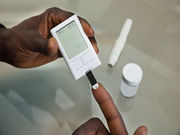Post-op HbA1c changes linked to improvement in Oswestry Disability Index, JOA, JOABPEQ scores
THURSDAY, Feb. 2, 2017 (HealthDay News) — Successful lumbar surgery is associated with improved glycemic control for patients with lumbar spinal stenosis (LSS) and type 2 diabetes mellitus (DM-2), according to a study published in the February issue of The Spine Journal.
In a prospective observational study, Kyoung-Tae Kim, M.D., Ph.D., from Kyungpook National University Hospital in Daegu, South Korea, and colleagues examined the effects of postoperative improvement in physical activity on body mass index (BMI) and hemoglobin A1c (HbA1c) in patients with LSS and DM-2. One hundred nineteen patients were enrolled and assessed over a two-year follow-up period.
The researchers found that the overall HbA1c values were 7.08 ± 0.94, 6.58 ± 0.87, 6.59 ± 0.79, and 6.59 ± 0.79 percent, respectively, before, and at six months, one year, and two years after surgery (P values: six months, 0.024; one year, 0.021, and two years, 0.038). The difference between pre- and postoperative HbA1c was statistically significant in the not well-controlled sugar group (P < 0.01). Statistically significant BMI reductions were seen in the second year after surgery in the overweight group (P = 0.034). There were strong correlations for postoperative HbA1c changes with improvements in the Oswestry Disability Index, Japanese Orthopaedic Association (JOA), and JOA Back Pain Evaluation Questionnaire scores.
“The present study demonstrates that in patients with DM-2 and LSS, successful lumbar surgery may facilitate glycemic control by enabling an increase in the patient’s level of physical activity,” the authors write.
Full Text (subscription or payment may be required)
Copyright © 2017 HealthDay. All rights reserved.








